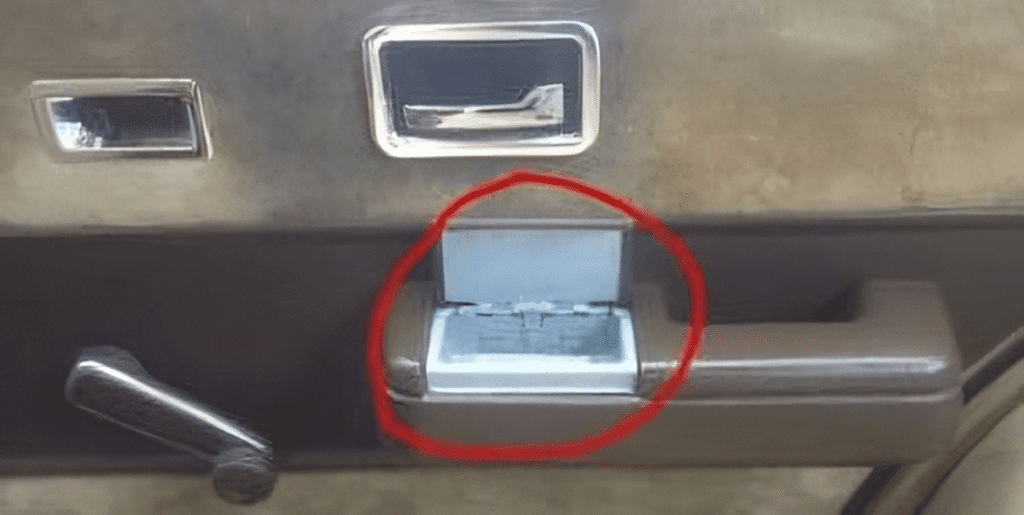If you can recall the days when every car had a built-in ashtray, then you’re either getting a bit older, or your car might be considered a classic. Ashtrays were once a common feature in almost every vehicle manufactured between the 1950s and the late 1990s. However, they have since become relics of the past, leaving many wondering why they disappeared and what that says about how our driving habits have evolved.
The Rise of the Car Ashtray: A Standard Feature

Back in the 1950s, smoking was a widespread habit, and naturally, people smoked everywhere—including their cars. Auto manufacturers responded by adding ashtrays as a standard feature in nearly every vehicle. These built-in ashtrays, often located in the dashboard or on the back of the front seats for passengers, provided a convenient way for drivers and passengers to dispose of cigarette ashes while on the road. It became such a normal part of car design that drivers rarely thought twice about its presence.
The ashtray, often combined with a cigarette lighter, symbolized an era where smoking was a common part of daily life. For decades, people lit up while driving, listening to the radio, or sitting in traffic. It was just another accessory, as essential as a glove compartment or a side mirror.
Why Ashtrays Started Disappearing in the 1990s
By the 1990s, car ashtrays were starting to fade from vehicles, much to the surprise of some smokers who had grown used to their presence. But why did this once-standard feature vanish from cars so quickly? Several factors contributed to the demise of the built-in ashtray, and each tells an interesting story about societal change.
First, there was a growing awareness of the health risks associated with smoking. The Surgeon General’s increasing warnings about the dangers of smoking, combined with widespread public health campaigns, led to a gradual shift in people’s attitudes toward tobacco. Fewer people were smoking, and those who did were being encouraged to quit. Car manufacturers responded to this cultural shift by removing ashtrays to reflect the changing habits of their customers.
Another reason was the demand for more technology and convenience features in cars. As cars began to evolve with electric windows, door locks, and entertainment systems, manufacturers needed to make space for new gadgets and controls. Ashtrays, once seen as a necessity, were deemed expendable in the pursuit of sleeker, more tech-filled interiors. The ashtray made way for cup holders, phone chargers, and other modern conveniences.
The Last Built-In Ashtray: A Farewell to the Flip-Up Design
By 1996, Chrysler became the last major automaker to stop including built-in ashtrays in its vehicles. It marked the end of an era. The once-glamorous flip-up ashtray that had been a staple of cars for nearly half a century was gone, replaced by cup holders, extra storage compartments, and more high-tech innovations.
For those who continued to smoke, the removal of the ashtray presented a small problem. Sure, you could purchase an aftermarket ashtray—often a small container that fits into your cup holder—but it didn’t have the same appeal as the built-in versions. Smokers were also offered a “smoker’s package” with some car models, which included a portable ashtray and lighter. However, these add-ons never fully captured the convenience and style of the old, built-in ashtrays.
Why People Miss the Car Ashtray

Though the decision to remove ashtrays was rooted in public health, some drivers still miss them. Smokers, of course, lament the loss of a convenient place to discard their cigarette ashes. But even non-smokers sometimes recall the built-in ashtray with a sense of nostalgia. For many, the ashtray was more than a functional feature—it was a part of the car’s personality.
Drivers used their ashtrays for all sorts of things, from holding loose change to stashing small items like keys or gum wrappers. The ashtray, tucked neatly into the dashboard, became a catch-all compartment for life’s little necessities. Its absence left a void for those who had repurposed it over the years, and the car interiors of today, while more advanced, seem to be missing that unique touch of utility.
A Reflection of Changing Times and Driving Habits
The removal of ashtrays from cars is a small but significant symbol of how our driving habits have changed over the years. Smoking, once a widely accepted habit, has declined sharply, thanks to health awareness campaigns and increased regulations on where people can smoke. The absence of the ashtray is a reminder of how society’s views on smoking have shifted—and how manufacturers have had to adapt to meet those changes.

Additionally, modern cars are packed with technology that drivers in the 1950s could never have imagined. With GPS systems, Bluetooth connectivity, and built-in infotainment systems, the focus in today’s car interiors is on connectivity and convenience. Car ashtrays, in comparison, now seem like a relic from a simpler time, when the biggest concern for many drivers was where to flick their ashes.
The Future of Clean Cars and Sustainable Design
As we move into an era of cleaner, more eco-friendly vehicles, the absence of ashtrays takes on an even greater significance. With the rise of electric vehicles and the push for sustainability, the design of car interiors has continued to evolve. Ashtrays, with their association to smoking and pollution, no longer have a place in the modern car.
Instead, manufacturers are focusing on reducing the environmental impact of their vehicles, with cleaner emissions, better fuel efficiency, and more sustainable materials. The disappearance of the ashtray may seem like a minor change, but it aligns with a larger trend of moving towards healthier, more responsible lifestyles—both inside and outside the car.
Conclusion: The Ashtray Fades, But the Memories Linger
While built-in ashtrays have mostly disappeared from modern vehicles, they still hold a place in the memories of those who grew up with them. The ashtray is a reminder of a different era in driving—a time when smoking was a common habit and cars were built with the assumption that every driver might need a place for their cigarette ashes.
Nowadays, as society becomes more health-conscious and technology takes center stage in vehicle design, the ashtray has become an obsolete feature. However, its disappearance reflects how our driving habits and preferences have evolved over the decades, offering a small yet meaningful glimpse into the ways that culture and technology shape the cars we drive today.